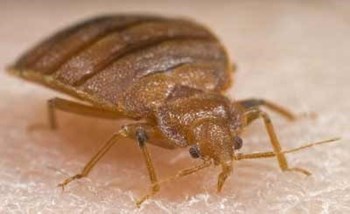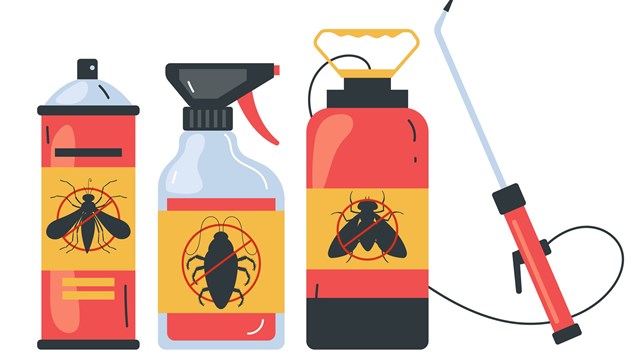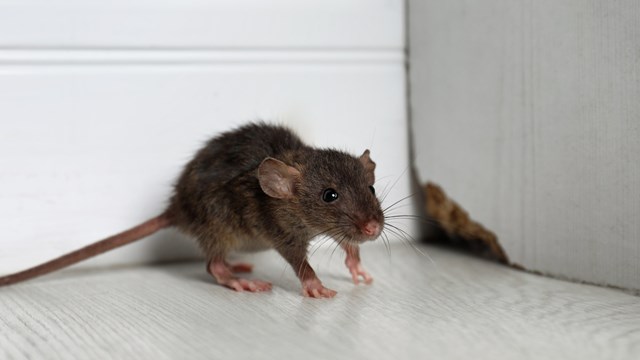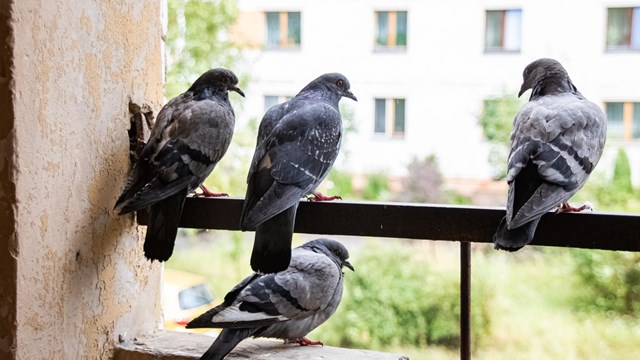
New York City and its surrounding boroughs have always been known for its robust population of vermin—rats and cockroaches have been part and parcel of city life ever since the Dutch settled here and founded New Amsterdam. While roach and rat populations have been largely controlled in the last few decades thanks to advances in insecticides, poison baits, and traps, another, perhaps even ickier pest critter has risen to take headlines and haunt city dwellers: the bed bug. According to the National Pest Management Association, complaints of bed bug infestation increased by 71 percent between 2000 and 2005, and the city's exterminators are reporting record numbers of calls about the problem.
Know Thy Enemy
Bed bugs are wingless insects (order: heteroptera, family: cimicidae, in case you've always wondered), having three main body parts and six legs, and are so small that they are nearly undetectable to the untrained eye (adults reach about one-quarter inch when fully grown). They travel in sneaky ways, as stowaways in luggage, and in more brazen ways—like across the ceiling and dropping onto you while you sleep. Their reclusive nature and tendency to hide in very hard-to-reach places have earned them a reputation for being at the top of the current most-insidious pest list.
Bed bugs feed on the blood of warm-blooded animals. Some afflict birds, some afflict bats, and some of them have a taste for human blood. With a very flat, oval-shaped body, they are experts at crevice hiding, and can lie dormant for extended periods, waiting for the next meal to appear.
Bed bugs get the signal to forage when they taste the scent of carbon dioxide (CO2) in the dark. Nighttime typically means increased production of CO2 while we sleep, and that's when the pests emerge to sip drops of blood from their host.
The process of biting is actually painless, but the bug injects a small amount of saliva into the wound, which then may cause an allergic reaction in some people. This is usually the first signal that a home may be infested.
According to the exterminators on the frontlines of the bed bug battle, that's just one way bed bugs are very different from their blood-sucking competition. "Bed bug bites do not itch and there will be multiple bites, whereas other bites, from mosquitoes and fleas, will itch," says Nana Kojo Ayesu of Kojo's Pest Elimination Company in the Bronx.
Itchy or not, bed bugs are elusive and daring. Ayesu paints a picture that makes them sound like agents from some diabolical Mission Impossible: "They will crawl across the ceiling, drop on top of you, walk all over you, lick you, and suck your blood," he says.
"Bed bugs reproduce at a rate of three or more generations per year," says Barry Beck of Assured Environments in Manhattan. "They can lay five eggs per day and about 500 in a lifetime. When they are in temperatures that range from 70 to 90 degrees, they can complete their development in 30 days."
These rates of reproduction are keeping pest control companies very busy lately. "Our bed bug business grew 500 percent from last year," says Beck. "It has become 20 percent of our one-time work."
Eradicating bed bugs is a different undertaking than dealing with other types of urban pests, according to Ayesu. "Roaches are dealt with along cracks and crevices," he says. "Bed bugs have to be sprayed all over the surface area."
Benett Pearlman of A Positive Pest Management Corporation in Whitestone is another warrior in the field. "They can travel down pipes, along corridors, down lines of apartments, and the whole building can often need extermination," he says.
Recent Visitors
"Bed bugs are prevalent in three continents that we know of: Africa, Europe and South America," says Pearlman. "Generally they are photonegative. You won't see them walking around like a roach."
The correlation between foreign travel and bed bug infestation is as strong today as it was in the past, when previous infestations were traced back to ships carrying goods and people from faraway shores. Today, foreign travel is universally cited as the primary factor in their recent spread.
"At the turn of 1900's we were inundated [by bed bugs] because of the influx of European immigrants, who have always had a bed bug issue," says Pearlman. "We got rid of them by the 1940s—with very strong chemicals which have since been banned. There were cases here and there, but you never really heard of them. It wasn't until the last five years that New York City became infested with bed bugs, compounded tenfold in the last couple of years."
"We have more visitors to New York City than since the turn of last century because of the low cost of visiting the city," continues Pearlman. "Also, more people are traveling from the U.S. and bringing them back."
Ayesu agrees. "Bed bugs were once not a problem. Now that people are getting bitten and suing—especially in hotels—they are gaining notoriety."
Maintenance and Prevention
"As far as prevention goes, if you have your whole house caulked and sealed, you will eliminate the chances of them getting in," says Pearlman. "If your place isn't caulked tight as a jar, you risk them retreating into the walls to reproduce and then return with a vengeance."
"Get plastic bed covers or vinyl and seal the zippers with tape so they can't climb in through the teeth," advises Pearlman. "If you caulk your home and put plastic over the mattresses you will stop them from getting into the deep crevices and folds."
"Cleanliness and tidiness are not deterrents to bed bug infestation," Ayesu stresses. "They hitch rides. When you go away for vacation or business, and put your clothes in the drawers, they will come with you."
Tips for keeping them out include:
1. When you travel, try to keep your clothes in your suitcase.
2. Check the seams and clothes for bed bugs before returning home.
3. Don't buy second-hand mattresses.
Choose Your Weapons
The good news is that furniture and mattresses do not have to be thrown out, as many people widely believe.
While the Internet is a great resource for the biology of the insect, the pest-control professionals are speaking with one voice about the efficacy of insecticides, powders, and sprays that are touted as bed bug solutions.
"Glue boards don't work," says Joel Sklar, also with Assured Environments. "Over-the-counter sprays will not work," says Ayesu. "Chemicals that you can buy as a non-professional will not work," says Pearlman.
Identification of the problem is the first step. "Not even a physician can tell a bed bug bite from the bite of other insects," says Sklar. "It definitely requires an inspection of the home."
"We come in with an arsenal of over $4,000 worth of equipment," says Sklar. "Bed bug infestation can be so severe that a return visit may be necessary—mostly because the eggs can be so deeply imbedded in the walls, and difficult to reach."
The trickiness of the bed bug makes hiring the right exterminator especially important. "If [an exterminator's] pre-treatment checklist is detail-oriented, you probably have a good exterminator," says Pearlman. "If he doesn't have a checklist, don't hire him. If the bugs aren't exterminated, you will be bitten again within three or four days."
The process of ridding an apartment or hotel of bed bugs is exhaustive. It begins with an inspection, which must be done by someone who is trained to look specifically for bed bugs. If bed bugs are identified as the culprits, then the real battle begins.
The steps generally include: removal of clothes (bag them, wash them, bag them again), checking mattresses for holes and spraying professional-grade insecticides on mattress tops and bottoms. Chemicals are also applied to the surrounding environment—not just the cracks and crevices where the anti-roach war is waged, but onto entire surface areas. A third chemical is used to get any existing eggs, and electrical outlets, drawers, and closets are carefully inspected and sprayed as well. After spraying, mattresses must be carefully sealed with plastic or vinyl and sealed shut with tape. A thorough steam cleaning is another step bed bug victims can take to rid their bedding and clothes of any lingering pests, and some exterminators offer special covers for mattresses, specifically designed to address the bed bug infestation while preserving more of the sleeping person's comfort. Some companies use a high-powered vacuum during the process of eradication as well.
The initial inspection and treatment process takes about three or four hours, and residents may return to the home an hour or so after that. Costs range from $100 per room and up, and generally start at around $500. Fees and quality of service may vary widely, so consumers should be careful about their choice.
Reputable, thorough exterminators are often able to eradicate a bed bug problem after just one visit, and will guarantee their success. If you have (or think you have) a bed bug problem, be sure to hire a company that stands behind its work and guarantees results. Still, even the best exterminator will tell you that re-infestation from adjacent apartments is not only possible, it is likely.
Who Pays?
"Because re-infestation is so likely, the responsibility for covering the cost of extermination [in a multifamily building] is something that is currently under debate," says Ayesu.
"New York City law says that you have the right to be free of pests, and bed bugs are considered a pest," says Pearlman. "The trouble is that owners are challenging that this particular type of pest is carried in on the person or in the luggage, as opposed to a pest that travels through the walls. What they are alleging in court is that the owner should not be responsible for a tenant who brings in these pests. There is starting to be new case law in New York on cases that are making the landlords culpable for bed bug treatment. Some digging may reveal new case law that can be used in court."
Leave it to New York City to drag a little bug the size of a lentil before a judge.
Joking aside however, the cost—both monetary and psychological —of having your home or building infested with nocturnal, bloodsucking insects is nothing to laugh about. If you suspect that you're hosting a colony of bed bugs, acting fast and decisively may be the ticket to limiting the scope and duration of the problem. Regardless, however, the bed bug situation in New York City looks like it might get worse before it gets better.
"It is a vicious war," says Ayesu.
Denton Tarver is a freelance writer living in New York City and a frequent contributor to The Cooperator.









4 Comments
Leave a Comment